Google Open Handset OS Intro
opengrok使用手册
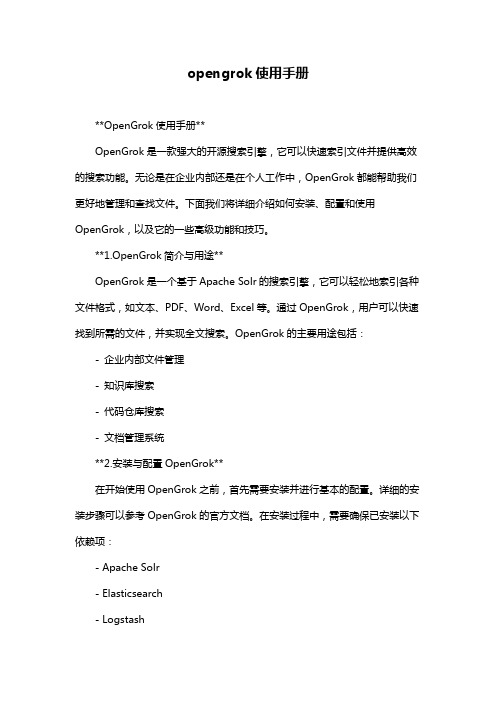
opengrok使用手册**OpenGrok使用手册**OpenGrok是一款强大的开源搜索引擎,它可以快速索引文件并提供高效的搜索功能。
无论是在企业内部还是在个人工作中,OpenGrok都能帮助我们更好地管理和查找文件。
下面我们将详细介绍如何安装、配置和使用OpenGrok,以及它的一些高级功能和技巧。
**1.OpenGrok简介与用途**OpenGrok是一个基于Apache Solr的搜索引擎,它可以轻松地索引各种文件格式,如文本、PDF、Word、Excel等。
通过OpenGrok,用户可以快速找到所需的文件,并实现全文搜索。
OpenGrok的主要用途包括:- 企业内部文件管理- 知识库搜索- 代码仓库搜索- 文档管理系统**2.安装与配置OpenGrok**在开始使用OpenGrok之前,首先需要安装并进行基本的配置。
详细的安装步骤可以参考OpenGrok的官方文档。
在安装过程中,需要确保已安装以下依赖项:- Apache Solr- Elasticsearch- Logstash- Jedis**3.探索OpenGrok的用户界面**OpenGrok的用户界面简洁直观,方便用户进行搜索和管理工作。
默认情况下,OpenGrok会自动创建一个索引库,并开始索引指定的文件。
在索引过程中,用户可以通过OpenGrok的搜索界面进行实时搜索。
搜索结果会根据文件内容和关键词的相关性进行排序。
**4.配置与使用OpenGrok插件**OpenGrok支持多种插件,以满足不同场景的需求。
用户可以根据实际情况选择并安装所需的插件。
以下是一些常用插件的简要介绍:- 文件过滤器:根据文件名或扩展名进行索引和搜索。
- 全文过滤器:仅索引和搜索指定标签的全文。
- 排序插件:根据指定字段对搜索结果进行排序。
**5.高级功能与技巧**OpenGrok的高级功能和技巧包括:- 使用正则表达式进行复杂搜索。
- 利用布尔操作符(AND、OR、NOT)进行组合搜索。
Google Gson教程(2016年版)说明书

About the T utorialGoogle Gson is an open source, Java-based library developed by Google. It facilitates serialization of Java objects to JSON and vice versa.This tutorial adopts a simple and intuitive way to describe the basic-to-advanced concepts of Google Gson and how to use its APIs.AudienceThis tutorial will be useful for most Java developers, starting form beginners to experts. After completing this tutorial, we are confident that you will find it easy to use Google Gson in your programs.PrerequisitesIt is a simple tutorial that any developer with a little exposure to Java programming can easily understand.Copyright & DisclaimerCopyright 2016 by Tutorials Point (I) Pvt. Ltd.All the content and graphics published in this e-book are the property of Tutorials Point (I) Pvt. Ltd. The user of this e-book is prohibited to reuse, retain, copy, distribute or republish any contents or a part of contents of this e-book in any manner without written consent of the publisher.We strive to update the contents of our website and tutorials as timely and as precisely as possible, however, the contents may contain inaccuracies or errors. Tutorials Point (I) Pvt. Ltd. provides no guarantee regarding the accuracy, timeliness or completeness of our website or its contents including this tutorial. If you discover any errors on our website or inthistutorial,******************************************T able of ContentsAbout the Tutorial (i)Audience (i)Prerequisites (i)Copyright & Disclaimer (i)Table of Contents (ii)1.Gson ─ Overview (1)Features of Gson (1)Three Ways of Processing JSON (2)2.Gson ─ Environment Setup (3)Local Environment Setup (3)Popular Java Editors (4)Download Gson Archive (4)Set Gson Environment (4)Set CLASSPATH variable (5)3.Gson ─ First Application (6)Example (6)Steps to Remember (7)4.Gson ─ Gson Class (9)Class Declaration (9)Constructors (9)Class Methods (9)Methods inherited (11)Example (11)5.Gson ─ Object Serialization (13)Example (13)6.Gson ─ Data Binding (16)Primitives Data Binding (16)Example (16)7.Gson ─ Object Data Binding (18)Example (18)8.Gson ─ Tree Model (20)Create Tree from JSON (20)Traversing Tree Model (20)Example (20)9.Gson – Streaming (23)Example (23)10.Gson ─ Serializati on Examples (27)Array Example (27)Collections Example (28)Generics Example (30)11.Gson ─ Serializing Inner Classes (34)Nested Inner Class example (34)Nested Static Inner Class Example (36)12.Gson ─ Custom Type Adapters (40)Create a Custom Adapter (40)Register the Custom Adapter (40)Use the Adapter (40)Example (41)13.Gson ─ Null Object Support (44)Example without serializeNulls Call (44)Example with serializeNulls call (46)14.Gson ─ Versioning Support (48)Example (48)15.Gson ─ Excluding Fields from Serialization (51)Example (51)Using excludeFieldsWithModifiers (53)Using @Expose Annotation (55)Google Gson 4Google Gson is a simple Java-based library to serialize Java objects to JSON and vice versa. It is an open-source library developed by Google.The following points highlight why you should be using this library: ∙Standardized - Gson is a standardized library that is managed by Google. ∙Efficient - It is a reliable, fast, and efficient extension to the Java standard library. ∙Optimized - The library is highly optimized. ∙Support Generics - It provides extensive support for generics. ∙ Supports complex inner classes - It supports complex objects with deep inheritance hierarchies.Features of GsonHere is a list of some of the most prominent features of Gson:∙ Easy to use ─ Gson API provides a high-level facade to simplify commonly used use-cases.∙ No need to create mapping ─ Gson API provides default mapping for most of the objects to be serialized.∙ Performance ─ Gson is quite fast and is of low memory footprint. It is suitable for large object graphs or systems.∙ Clean JSON ─ Gson creates a clean and compact JSON result which is easy to read.∙ No Dependency ─ Gson library does not require any other library apart from JDK.∙Open Source ─ Gson library is open source; it is freely available. Three Ways of Processing JSONGson provides three alternative ways to process JSON:1.Google Gson5Streaming APIIt reads and writes JSON content as discrete events. JsonReader and JsonWriter read/write the data as token, referred as JsonToken .It is the most powerful approach among the three approaches to process JSON. It has the lowest overhead and it is quite fast in read/write operations. It is analogous to Stax parser for XML.Tree ModelIt prepares an in-memory tree representation of the JSON document. It builds a tree of JsonObject nodes. It is a flexible approach and is analogous to DOM parser for XML. Data BindingIt converts JSON to and from POJO (Plain Old Java Object) using property accessor. Gson reads/writes JSON using data type adapters. It is analogous to JAXB parser for XML.Google Gson 6Try it Option OnlineYou do not have to set up your own environment to start learning Gson. We have already set up an online Java Programming environment for you. This platform allows you to compile and execute all the available examples online and analyze the output with different options. We believe it will boost your confidence and make your learning an enjoyable activity. Feel free to modify any example and execute it online.Try the following example using the Try it option available at the top right corner of the following sample code box:For most of the examples given in this tutorial, you will find a Try it option. Please do use this option and enjoy your learning.Local Environment SetupIf you still want to set up a local environment for Java programming language, then this section will guide you on how to download and set up Java on your machine. Please follow the steps given below, to set up the environment.Java SE is freely available from the link Download Java . You need to download a version based on your operating system.Follow the instructions to download Java and run the .exe to install Java on your machine. Once you have installed Java on your machine, you would need to set the environment variables to point to their correct installation directories.Setting up the Path in Windows 2000/XPAssuming you have installed Java in c:\Program Files\java\jdk directory: ∙ Right-click on 'My Computer' and select 'Properties'.∙ Click on the 'Environment variables' button under the 'Advanced' tab.2.∙Next, alter the 'Path' variable so that it also contains the path to the Java executable.For example, if the path is currently set to 'C:\WINDOWS\SYSTEM32', then change your path to read 'C:\WINDOWS\SYSTEM32;c:\Program Files\java\jdk\bin'.Setting up the Path in Windows 95 / 98 / MEAssuming you have installed Java in c:\Program Files\java\jdk directory:∙Edit the 'C:\autoexec.bat' file and add the following line at the end: 'SET PATH=%PATH%;C:\Program Files\java\jdk\bin'Setting up the Path for Linux, UNIX, Solaris, FreeBSDThe environment variable PATH should be set to point to where the Java binaries have been installed. Refer to your shell documentation if you have trouble doing this.For example, if you use bash as your shell, then you would add the following line to the end of your '.bashrc: export PATH=/path/to/java:$PATH'Popular Java EditorsTo write your Java programs, you will need a text editor. There are quite a few sophisticated IDEs available in the market. But for now, you can consider one of the following: ∙Notepad:On Windows, you can use any simple text editor like Notepad (Recommended for this tutorial) or TextPad.∙Netbeans: It is a Java IDE that is open-source and free which can be downloaded from /index.html.∙Eclipse: It is also a Java IDE developed by the Eclipse open-source community and can be downloaded from /.Download Gson ArchiveDownload the latest version of Gson jar file from gson-2.3.1.jar. At the time of writing this tutorial, we downloaded gson-2.3.1.jar and copied it into C:\>gson folder.7Set Gson EnvironmentSet the GSON_HOME environment variable to point to the base directory location where Gson jar is stored on your machine.Set CLASSP A TH variableSet the CLASSPATH environment variable to point to the Gson jar location.8Google Gson 9Before going into the details of the Google Gson library, let's see an application in action. In this example, we've created a Student class. We'll create a JSON string with student details and deserialize it to student object and then serialize it to an JSON String. ExampleCreate a Java class file named GsonTester in C:\>GSON_WORKSPACE. File: GsonTester.java3.Verify the resultCompile the classes using javac compiler as follows:Now run the GsonTester to see the result:Verify the output.Steps to RememberFollowing are the important steps to be considered here.Step 1: Create Gson object using GsonBuilder10Create a Gson object. It is a reusable object.Step 2: Deserialize JSON to ObjectUse fromJson() method to get the Object from the JSON. Pass Json string / source of Json string and object type as parameter.Step 3: Serialize Object to JSONUse toJson() method to get the JSON string representation of an object.11End of ebook previewIf you liked what you saw…Buy it from our store @ https://12。
OpenCore_Introduction

7.{
8.LOGE("Couldn't open fd for %s", url);
9.return UNKNOWN_ERROR;
10.}
11.setDataSource(fd, 0, 0x7fffffffffLL); // this sets mStatus
12.close(fd);
plaincopy to clipboardprint?
1.virtual void sendEvent(int msg, int ext1=0, int ext2=0) { if (mNotify) mNotify(mCookie, msg, ext1, ext2); }
mNotify是MediaPlayerBase的一个成员变量,它是一个函数指针,原型如下:
int main(int argc, char** argv)
{
sp<ProcessState> proc(ProcessState::self());
sp<IServiceManager> sm = defaultServiceManager();
LOGI("ServiceManager: %p", sm.get());
例如上面所提到的createPlayer(playerType)这个函数,当你需要添加自己的特殊格式的播放器的时候,就不用来改它本来的代码,而只用在createPlayer(playerType)的实现下面几行代码:
view plaincopy to clipboardprint?
1.case XXX_PLAYER:
13.return mStatus;
gPad

gPad
GPad平板电脑在内置了Office软件的基础上,还能让用户在工作之余享受到趣味多彩的小游戏。 目前,络上Flash小游戏已经风靡学生人群及白领人群,像Flash版《植物大战僵尸》等小游戏 如雨后春笋般出现在各大站上。
而长城电脑GPad独特的触控技术以及顺畅的Flash播放功能,使其成为玩Flash游戏的最佳选择。 长城的这款GPad平板电脑很开放,强大的Flash播放引擎支持多格式的Flash播放。而GPad先进 的压感触屏技术大大提升了Flash游戏的玩赏性,同时各种基于触屏的新奇Flash小游戏也得到 了不少小游戏爱好者的青睐。
智能导航
谢谢观看
2010年1月27日,苹果正式发布了宣传已久的平板电脑,但业界发现,iPad并没有推出什么很具 有革命性的功能特性,操作系统都是iPhone OS,这让众多“果粉”大为失望,“感觉苹果的 iPad就是一个放大版的iPodtouch”。媒体纷纷表示,iPad“非常像一个大号的iPhone”、魅族 则从称之为“大号的MP4”。宏碁、联想等PC巨头也表示了无意尝试平板电脑。
gPad
《eWeek》认为,与苹果iPad相比,谷歌Chrome OS平板电脑至少具备两大市场优势:一是谷歌 将同多家厂商合作,以推出不同款式的Chrome OS平板电脑,而不像iPad仅出自苹果;二是 Chrome OS为谷歌首款真正意义上的络操作系统,其市场革新意义远大于iPad。
苹果iPad发布之后,Google看到了更多的希望。
一位Google发言人在邮件中说道:“ChromeOS正处于开发之中,并且我们不断地通过来自不同 用户的体验来修改这系统到底怎样设计才能提供给更好的使用体验。就像我们曾说过的,系统UI 界面仍在开发之中并且会不断的调整以便供给用户最佳体验。”
open_harmony代码剖析600字
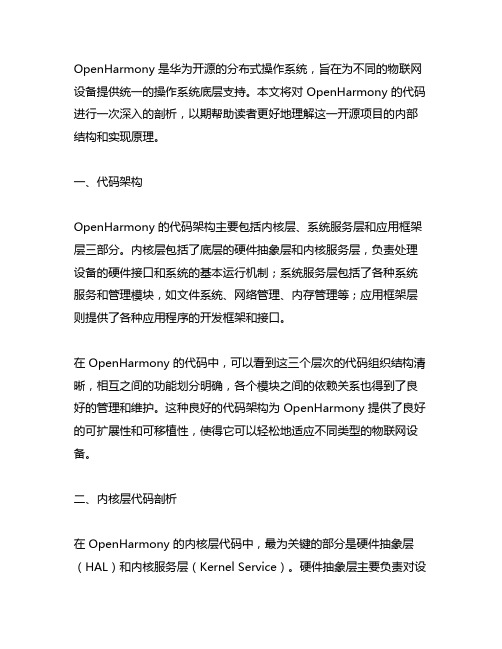
OpenHarmony 是华为开源的分布式操作系统,旨在为不同的物联网设备提供统一的操作系统底层支持。
本文将对 OpenHarmony 的代码进行一次深入的剖析,以期帮助读者更好地理解这一开源项目的内部结构和实现原理。
一、代码架构OpenHarmony 的代码架构主要包括内核层、系统服务层和应用框架层三部分。
内核层包括了底层的硬件抽象层和内核服务层,负责处理设备的硬件接口和系统的基本运行机制;系统服务层包括了各种系统服务和管理模块,如文件系统、网络管理、内存管理等;应用框架层则提供了各种应用程序的开发框架和接口。
在 OpenHarmony 的代码中,可以看到这三个层次的代码组织结构清晰,相互之间的功能划分明确,各个模块之间的依赖关系也得到了良好的管理和维护。
这种良好的代码架构为 OpenHarmony 提供了良好的可扩展性和可移植性,使得它可以轻松地适应不同类型的物联网设备。
二、内核层代码剖析在 OpenHarmony 的内核层代码中,最为关键的部分是硬件抽象层(HAL)和内核服务层(Kernel Service)。
硬件抽象层主要负责对设备硬件进行抽象和管理,将各种硬件设备的接口和功能进行统一,为上层的系统服务层和应用框架层提供统一的硬件接口。
内核服务层则负责处理系统的基本运行机制,包括进程管理、调度管理、中断处理等。
在 HAL 部分的代码中,可以看到对各种硬件设备的抽象接口定义和实现,这些接口将各种硬件设备的底层操作进行了统一,为系统的可移植性提供了保障。
在 Kernel Service 部分的代码中,则包括了对进程管理、调度管理等基本系统调度和管理功能的实现,这些功能的稳定性和高效性对整个系统的性能和稳定性都有着至关重要的作用。
三、系统服务层代码剖析系统服务层的代码主要包括了文件系统、网络管理、内存管理等一系列系统服务和管理模块。
在文件系统部分的代码中,可以看到对文件系统的各种操作接口和功能的定义和实现,这些接口和功能的稳定性和高效性对系统的数据存储和管理都有着重要的作用。
使用open harmony开发的案例

题目:Open Harmony开发案例分析一、介绍Open HarmonyOpen Harmony是华为公司推出的开源操作系统,旨在打造一个通用易用的物联网设备操作系统。
它具有跨设备、多场景、高安全等特点,可以广泛应用于智能家居、智能穿戴、车载系统等物联网设备领域。
Open Harmony采用Apache 2.0开源许可证,任何开发者都可以免费获取并使用这一操作系统。
二、Open Harmony开发案例在各种物联网设备中,固件升级一直是一个重要的课题。
本文将从固件升级的场景出发,介绍一个基于Open Harmony开发的案例。
1. 需求分析某智能家居公司希望为其智能插座产品实现固件远程升级功能。
用户通过手机APP即可对智能插座的固件进行升级,而无需打开插座外壳手动升级固件。
2. 技术选型考虑到Open Harmony的开源特性和跨设备优势,该公司决定选用Open Harmony作为智能插座的操作系统。
Open Harmony具有轻量级、高安全性、可定制性等特点,非常适合智能插座这类小型设备的开发。
3. 开发过程(1)设备端开发:开发团队基于Open Harmony,设计并实现了智能插座的固件升级功能。
他们利用Open Harmony提供的OTA (Over-The-Air)升级框架,为智能插座制定了固件升级策略,并实现了固件下载、验证、升级等逻辑。
(2)云端开发:开发团队在云端搭建了一个固件管理评台,用于管理不同版本的固件,并与智能插座进行交互。
用户通过手机APP选择升级固件时,云端评台即可下发升级指令,并监控升级的进度和结果。
4. 测试与上线经过设备端和云端的开发工作,开发团队进行了全面的测试工作,包括功能测试、性能测试、安全测试等。
确保固件远程升级功能的可靠性和稳定性。
在保证质量的前提下,成功将这一功能上线。
5. 收益分析通过Open Harmony开发的固件远程升级功能,该智能家居公司为用户提供了更便捷的固件升级体验,提升了用户满意度。
GoogleChromeOS操作系统试用

GoogleChromeOS操作系统试用GoogleChromeOS操作系统试用在虚拟机上新安装了一个根据开源Chromium源码编译好的Chrome OS镜像文件进行试用测试,颇有一些感慨。
Chrome OS省去了其他操作系统“用户的概念,不需要本地的用户系统,而是使用Google帐号(如Gmail帐号)登录,因此必须要联网。
登录进去之后,整个系统的界面真是干干净净,就是一个Chrome浏览器,其他什么多余的功能都没有,所有数据都保存在服务器端,所有的应用都是网页应用,这个操作系统,完完全全就是一个浏览器,或者说,一个两百多兆的浏览器。
对于普通用户来说,完全没有必要下载这个操作系统来“尝鲜,只需要在电脑上安装Chrome浏览器即可,因为两者几乎完全一样,区别非常小。
据Google介绍,当前版本的Chrome OS启动只需7秒,启动速度的确很快,现在大多数Windows电脑启动速度都在两分钟以上,不过,这种高速启动是以放弃对本地多样化硬件的支持换取的,因为所有的数据都在服务器端,因此本地不需要太多的硬件,甚至连硬盘也不需要,试想一下,当年的WIndows 98启动速度不也只有十几秒,对硬件支持少,启动速度当然就快,DOS启动不是更快?Chrome OS的界面,简单而浏览器应用在系统的安全性和可用性上来讲,没有本地文件和桌面系统将带来很大的不便,Chrome OS要求将所有用户数据保存在服务器端,联网后获取数据,至少在中国,短时间内是不可能的。
因为这里不可能实现随时联网,网络中断的现象如同家常便饭,没有网络连接,一切网页应用都将瘫痪,用户将无法访问自己的数据,无法进行操作,什么都做不了,而如果有本地的桌面软件,那就完全可以离线完成所有的应用,因此,只要中国的网络大环境一天得不到改善,数据保存在本地还是最安全可靠的。
Chrome OS的选项菜单,与单纯浏览器的最大区别没有本地文件系统,一切都是网页应用,这个想法很超前,即使智能手机也有本地文件系统,只有纯粹的网络应用才符合这样的需求,因此上网本操作系统就是Chrome OS的目标群体。
交互界面的字体设计案例

交互界面的字体设计案例
以下是交互界面字体设计的案例:
1. Google Sans:
Google Sans是Google为其品牌提供的定制字体。
它是一种优雅,简洁,现代的无衬线字体,具有卓越的可读性和易于识别的特性。
这种字体在谷歌Android操作系统和其他Google产品中广泛使用。
2. Open Sans:
Open Sans是一种由Google设计的无衬线字体。
它是一种非常通用的字体,适用于各种操作系统,网站,应用程序和其他数字媒体。
Open Sans具有非常良好的可读性和清晰度,是一种很受欢迎的字体。
3. Gotham:
Gotham是一种现代无衬线字体,其延伸版本用于一些比较大规模的项目。
该字体设计简约而美观,同时也是一种非常可读的字体,适用于各种类型的内容和场景。
Gotham是许多品牌的选择,其中包括亚马逊和HBO。
4. Proxima Nova:
Proxima Nova是一种流行的无衬线字体,它具有现代,简洁
的设计和高度的可读性。
它是一种高端字体,广泛适用于印刷品,移动应用程序和其他数字产品。
Proxima Nova是一种灵活的字体,适用于各种媒介。
5. Montserrat:
Montserrat是一种受到现代哥特式印刷的启发的无衬线字体。
它是一种非常干净,现代的设计,适用于各种用途。
Montserrat免费提供使用,可以在许多数字项目中找到,包括网站,应用程序,印刷品和广告。
openharmony 发展史
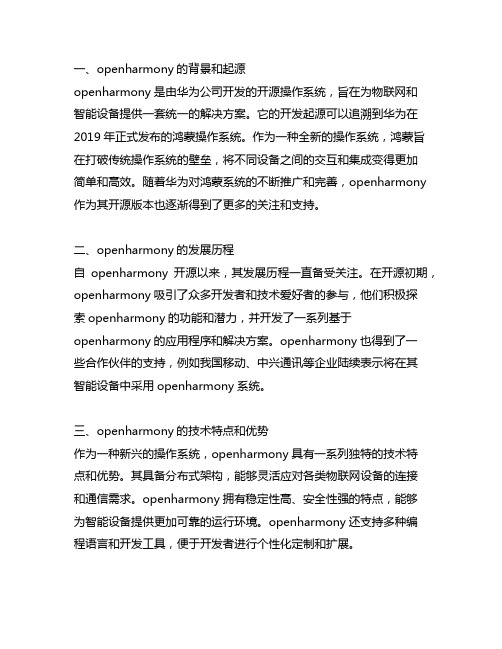
一、openharmony的背景和起源openharmony是由华为公司开发的开源操作系统,旨在为物联网和智能设备提供一套统一的解决方案。
它的开发起源可以追溯到华为在2019年正式发布的鸿蒙操作系统。
作为一种全新的操作系统,鸿蒙旨在打破传统操作系统的壁垒,将不同设备之间的交互和集成变得更加简单和高效。
随着华为对鸿蒙系统的不断推广和完善,openharmony 作为其开源版本也逐渐得到了更多的关注和支持。
二、openharmony的发展历程自openharmony开源以来,其发展历程一直备受关注。
在开源初期,openharmony吸引了众多开发者和技术爱好者的参与,他们积极探索openharmony的功能和潜力,并开发了一系列基于openharmony的应用程序和解决方案。
openharmony也得到了一些合作伙伴的支持,例如我国移动、中兴通讯等企业陆续表示将在其智能设备中采用openharmony系统。
三、openharmony的技术特点和优势作为一种新兴的操作系统,openharmony具有一系列独特的技术特点和优势。
其具备分布式架构,能够灵活应对各类物联网设备的连接和通信需求。
openharmony拥有稳定性高、安全性强的特点,能够为智能设备提供更加可靠的运行环境。
openharmony还支持多种编程语言和开发工具,便于开发者进行个性化定制和扩展。
四、openharmony在物联网领域的应用前景随着物联网技术的快速发展,openharmony在物联网领域的应用前景也备受瞩目。
作为一种开放、灵活的操作系统,openharmony能够为各类智能设备提供统一的解决方案,促进设备之间的互联和互通。
openharmony不仅能够为智能家居、智能穿戴等领域的应用提供支持,还能为未来更多的物联网应用场景提供技术保障。
五、openharmony面临的挑战和发展方向尽管openharmony在物联网领域具有广阔的应用前景,但其面临的挑战也不容忽视。
google openapi用法
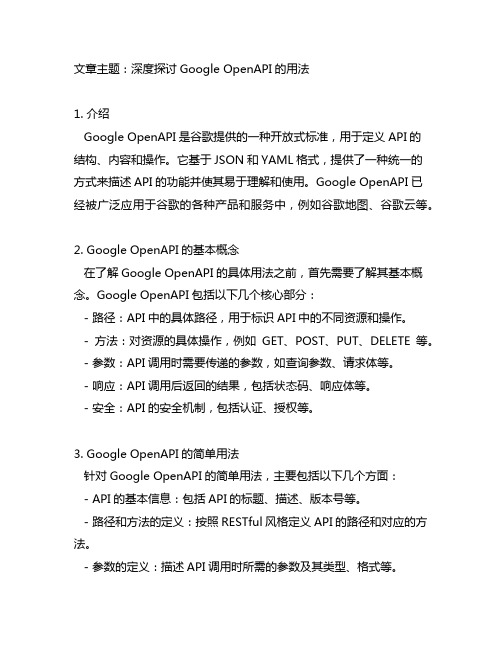
文章主题:深度探讨Google OpenAPI的用法1. 介绍Google OpenAPI是谷歌提供的一种开放式标准,用于定义API的结构、内容和操作。
它基于JSON和YAML格式,提供了一种统一的方式来描述API的功能并使其易于理解和使用。
Google OpenAPI已经被广泛应用于谷歌的各种产品和服务中,例如谷歌地图、谷歌云等。
2. Google OpenAPI的基本概念在了解Google OpenAPI的具体用法之前,首先需要了解其基本概念。
Google OpenAPI包括以下几个核心部分:- 路径:API中的具体路径,用于标识API中的不同资源和操作。
- 方法:对资源的具体操作,例如GET、POST、PUT、DELETE等。
- 参数:API调用时需要传递的参数,如查询参数、请求体等。
- 响应:API调用后返回的结果,包括状态码、响应体等。
- 安全:API的安全机制,包括认证、授权等。
3. Google OpenAPI的简单用法针对Google OpenAPI的简单用法,主要包括以下几个方面:- API的基本信息:包括API的标题、描述、版本号等。
- 路径和方法的定义:按照RESTful风格定义API的路径和对应的方法。
- 参数的定义:描述API调用时所需的参数及其类型、格式等。
- 响应的定义:定义API调用后返回的结果及其格式、内容等。
4. Google OpenAPI的高级用法除了基本的用法外,Google OpenAPI还支持一些高级的功能和技术,例如:- 模型定义:定义API中使用的数据模型,包括对象、数组、枚举等。
- 安全定义:定义API的安全机制,包括OAuth、API密钥等。
- 拓展功能:使用Google OpenAPI的拓展功能,如信息、参数组等。
- 文档生成:通过Google OpenAPI的规范,可以生成API的文档并提供给用户参考。
5. Google OpenAPI的个人见解对于Google OpenAPI的个人观点和理解,我认为这是一种非常强大和灵活的API描述方式。
物联网八大操作系统

物联网八大操作系统在当今数字化的时代,物联网(Internet of Things,简称 IoT)正以前所未有的速度改变着我们的生活和工作方式。
而在物联网的世界中,操作系统扮演着至关重要的角色,它们就像是物联网设备的“大脑”,负责管理和协调各种硬件资源,运行应用程序,以及实现设备之间的通信和数据交换。
下面,让我们一起来了解一下物联网领域中的八大操作系统。
一、Android ThingsAndroid Things 是谷歌推出的一款专门为物联网设备打造的操作系统。
它基于 Android 操作系统,具有强大的生态系统和丰富的开发资源。
Android Things 支持多种硬件平台,包括树莓派、英特尔 Edison 等,使得开发者能够轻松地将现有的 Android 开发技能应用到物联网项目中。
此外,Android Things 还提供了一系列的 API 和工具,用于连接传感器、执行器和云服务,为开发者构建智能物联网设备提供了便利。
二、Windows 10 IoT Core微软的 Windows 10 IoT Core 是 Windows 10 操作系统的一个物联网版本。
它旨在为小型、低功耗的物联网设备提供一个熟悉的 Windows开发环境。
Windows 10 IoT Core 支持多种硬件架构,如 ARM 和 x86,并且可以运行 UWP(Universal Windows Platform)应用程序。
这使得开发者能够利用现有的 Windows 开发工具和技术,快速创建具有丰富用户界面和强大功能的物联网设备。
三、LinuxLinux 是一个开源的操作系统,在物联网领域也有着广泛的应用。
由于其高度的可定制性和灵活性,Linux 可以被裁剪和优化以适应各种不同的物联网设备需求。
无论是智能家居设备、工业自动化设备还是智能交通系统,都可以基于 Linux 进行开发。
此外,Linux 拥有庞大的开源社区和丰富的驱动程序资源,为开发者提供了强大的支持。
Google+ Hangouts 使用说明书

How to get startedwith your first HangoutGoogle+ makes connecting on the web more like connecting in the realworld. Hangouts are a great way to have a personal conversation withcustomers or colleagues, from different time zones, and in different places,all at the same time.What is a Hangout?Hangouts are one-click video conversations that let you receive face-to-face feedback about a product or to create buzz for a product launch. FiatNederland, for example, hosted a Hangout to reveal its latest car designs.Types of HangoutsYou can use Hangouts for many different purposes, from announcing productsto hosting seminars or meetings with people in different locations. Here are afew ideas:+ C ustomer service: Host Hangouts at regular times, so followers can askquestions and receive live support.+ C ustomer feedback sessions: Be sure to take notes on customers’thoughts and ideas in a live Google doc.+ P roduct demos, seminars, and live training: Explain to your customershow to best use your latest products or services. You’ll also receive instantfeedback.There are two types of Hangouts:+ P ublic Hangouts:Anybody can join these open Hangouts on a first-come, first-served basis.Invite your fans to participate via public posts, other social media networks,and newsletters.+ E xclusive Hangouts:Send invitations or pre-select your participants. Cadbury, for instance, askedfollowers on its Google+ page what they would ask during a Hangout. Thecompany then invited the followers with the best questions. Alternatively,you can choose to invite your most engaged brand advocates. Find out whothey are on Google+ by using Ripples.Quick tips:+ J oin Hangouts on Google+ tosee how others use them—it’sa good way of getting started.+ C hoose a topic related to yourbusiness or brand that peoplelike to talk about. Participantswill be more engaged, and yourHangout will be more exciting.+ T ry making your first Hangout20 minutes long. You can alwaysmake the next one longer orshorter.Cool stuff you can do during a Hangout Here are some tips for having engaging Hangouts, depending on what you want to do:+ S hare presentations and videos. Hangouts allow you to share your screen, go through a presentation together, or watch a YouTube video. + W ork in the same document. Hangouts with extras also let you open a new or existing Google doc, so everyone in the Hangout can work on it at the same time. With Sketchpad, you can even create drawings together. Just look for the Try Hangouts with extras bar at the bottom of the window.+ R ecord your Hangout . Make an active collection of all your Hangoutsaccessible for everyone by posting them in the Video section of your Google+ page, on your website, and on YouTube.Promoting your first HangoutHosting your first Hangout is exciting, so make sure to promote it well. Make a short video invitation that explains the Hangout time and topic, and share it on your Google+ page. Post announcements a week before, the day before, the morning of, and an hour before the Hangout for maximum awareness. I nclude an announcement for the Hangout in all your other communication channels, such as your website, blog, other social media, and your offline media. T o generate extra PR for your Hangout, invite a guest who will excite your followers—a celebrity, your lead product designer, or CEO. Announce the appearance publicly, and ask your guest speaker to add your page to his or her Circles. Also, invite your guest to a Hangout hosted by your page.Setting up your HangoutThis is all you need to do:+ L og in to your Google+ page.+ S tart a Hangout from the right side of the stream.After the Hangout+ C reate a short video of the Hangout and share it on Google+ and othersocial networks. Share the video in a post on your Google+ page, for example. Store it in the Video section too. By using Ripples, you can even see how your video has been shared across Google+.+ Thank the participants for joining, and ask for their feedback.+ Set expectations for when you might host your next Hangout.+ E valuate and learn from your Hangout. Did it work for you? Did theattendees have fun and gain value? Did you and your team? What can you improve? Even if it isn’t perfect the first time, learn from your Hangout, keep practising, and find the best way to connect with your followers.Please visit our help centre if you have any questions. /plus/?hl=en+ D o a test run with someparticipants or colleagues before your first Hangout, to make sure you understand how it works. Check that the light in the room and the quality of your webcam are sufficient.+ U se a wired connection,never wireless. Have a backup connection in case your primary fails.+ H ave a list of topics or a roughscript, to guide the conversation without being too obvious.Have fun with all your circlesusing your live webcam.Hangouts © 2012 Google Inc. All rights reserved. Google and the Google logo are trademarks of Google Inc. All other company and product names may be trademarks of the respective companies with which they are associated.Your circles + Add more people+ S end invitationsto guests.+ G et started as theguests join you in your Hangout.。
谷歌开放式创新的例子

谷歌开放式创新的例子
谷歌是一家以开放式创新著称的公司。
它将创新作为其战略核心,并通过开放思维、开放文化和开放生态系统来实现其愿景。
以下是谷歌开放式创新的例子:
1. Google Labs:Google Labs是谷歌的一个实验室,旨在挖掘和发掘新的创新技术和想法。
该实验室不仅提供了一系列的新产品和技术,还鼓励用户通过测试和反馈来参与到产品开发中。
2. Android:Android是谷歌的一个开源移动操作系统,它为智能手机和平板电脑提供了一个全面的软件平台。
谷歌与许多硬件制造商和移动运营商合作,共同开发和推广Android平台,以满足不同用户的需求。
3. Google Maps:Google Maps是谷歌的一个在线地图服务,它为用户提供全球范围内的详细地图、卫星图片和街景图像等。
谷歌不仅自主开发了Google Maps,还通过开放API 让开发者和创业公司可以很容易地集成该服务到其应用中,以建立更多基于地理位置的应用。
4. Googlers 20%时间政策:谷歌有个著名的创新政策,即“20%时间”。
员工可以利用工作时间的20%自由探索和尝试自己的想法和概念,这种开放的创新文化鼓励员工勇于尝试、创新思维、培养创造力。
5. Google AdSense:Google AdSense是谷歌的一个广告分发平台,它允许网站主通过在网站上放置广告来获取收入。
谷歌的广告系统开放给所有网站主,并根据其网站内容和受众定位来匹配广告内容,从而实现系统自动优化。
总之,谷歌的开放式创新文化和生态系统得到了广泛认可和欢迎,这种模式既激发员工的创新思维和潜力,又提供了一个繁荣的生态系统,为社会带来了更多的创新和价值。
google设计理念

google设计理念Google设计理念Google作为全球知名的科技公司,一直以来都以简洁、易用、高效的设计著称。
其设计理念秉承着一系列原则,使得用户能够通过简单的操作实现复杂的任务,享受到更好的用户体验。
一、简洁明了Google的设计一直以来都以简洁为主要特点。
其主页以白色为主色调,没有繁琐的广告和冗余的设计元素,使得用户能够迅速找到所需信息。
同时,Google的搜索结果页面也采用了简洁的设计,只展示核心信息,减少干扰,提高搜索效率。
二、自动化与人工智能Google通过自动化和人工智能技术,不仅优化了用户的搜索结果,还简化了操作步骤。
例如,Google搜索会自动补全搜索词,提供相关的搜索建议,使得用户可以更快捷地找到所需信息。
此外,Google还通过机器学习算法,根据用户的搜索历史和行为,提供个性化的搜索结果和广告推荐,提升用户的满意度。
三、多平台适配Google的设计理念还包括多平台适配。
无论是移动设备、平板电脑还是桌面电脑,Google的产品都能够在不同平台上提供一致的用户体验。
通过响应式设计和自适应布局,用户可以在不同的设备上使用相同的功能和界面,方便快捷。
四、用户参与与反馈Google注重用户参与与反馈,积极听取用户的意见和需求。
通过用户调查、用户反馈等方式,Google不断优化产品的设计和功能,使得用户能够享受到更好的体验。
此外,Google还鼓励用户通过社交媒体和开放平台,参与到产品的开发和改进中。
五、数据驱动与实验Google的设计理念还强调数据驱动和实验。
通过数据分析和用户行为研究,Google不断改进产品的设计和功能,提升用户的满意度。
同时,Google也鼓励团队进行实验,通过不断试错和迭代,不断提高产品的性能和用户体验。
六、关注隐私和安全Google的设计理念还关注用户的隐私和安全。
作为用户信任的基础,Google采取了一系列措施,保护用户的个人信息和数据安全。
例如,Google加密用户的搜索数据,限制广告追踪,提供安全的云存储服务等,使得用户能够安心使用产品。
谷歌发布开源安全芯片设计项目open titan

2019年11月5日,第二届中国国际进口博览会在上海开幕。
阿里巴巴集团董事局主席兼首席执行官张勇表示,“很多人会问我,逍遥子你预测一下今年‘双11’多少数据,今年第11年了,(我)从来不回答这个问题。
”张勇解释,“其实在我心里最关键的,不是销售数字,而是我们整个技术的峰值,我们能够每秒钟支撑多少笔订单的处理,既不发生钱的错误,又不发生错误的库存和被错误地记录,这才能保证整个商业的顺畅运转。
”每年“双11”,都对阿里的技术部门是一次大考。
今年,阿里是如何应对的呢?原来,“双11”消费者在狂欢时,数据中心也在24小时运转。
阿里巴巴有上百万台服务器在为全社会提供计算服务,每降低一台服务器的能耗都能为全社会节约大量资源。
传统数据中心,有近40%的能源消耗在散热制冷上,能源使用效率很低。
因此,阿里工程师想了个巧妙的方法:把服务器浸泡在特殊冷却液里,产生热量可被冷却液直接带走进入外循环自然冷却,全程用于散热的能耗几乎为零,整体节能70%。
此外,机器智能也被应用到数据中心里,算法模型可根据外部温度优化服务器负载,实现智能化电力和热能管控。
就这样,靠着自主研发的液冷、深层水冷等技术,阿里巴巴工程师们将数据中心的节能效果逼近极限,将每万笔电商交易的耗电量控制在2度电以内,这意味着仅“双11”一天,就能为社会节省超过20万度电。
今年“双11”将是史上最绿色的一届双11,除了更省电的数据中心外,菜鸟引领的包裹瘦身算法、AI 设计师鹿班、电子面单和智能客服等都为全社会的双11贡献了“绿色KPI ”。
目前,“液冷服务器”已在阿里张北数据中心大规模部署。
阿里工程师把服务器泡在水里节能效果超70%■车满■吕惠近日,谷歌公司发布了OpenTitan 这个开源项目,旨在鼓励厂家为数据中心和消费级设备开发所谓的信任根(root-of-trust )技术。
如果一个系统被称为拥有信任根,这意味着它有专门的芯片或模块负责阻击黑客攻击。
比如说,在谷歌的最新Pixel 4手机中,Titan M 微控制器扮演这个角色。
gms认证 fingerprint格式
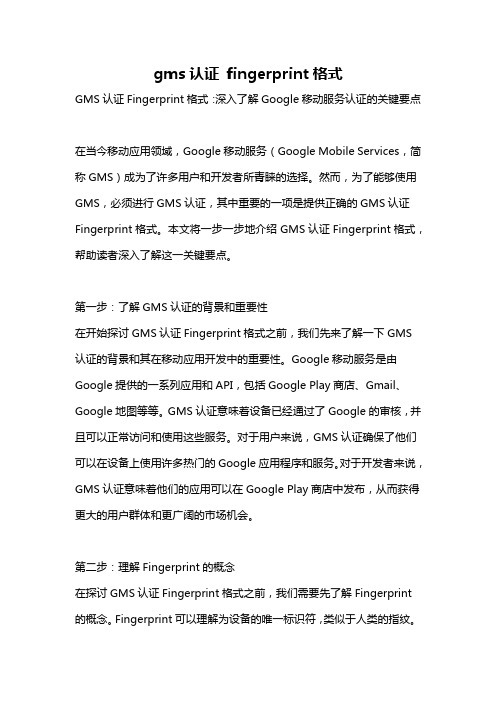
gms认证fingerprint格式GMS认证Fingerprint格式:深入了解Google移动服务认证的关键要点在当今移动应用领域,Google移动服务(Google Mobile Services,简称GMS)成为了许多用户和开发者所青睐的选择。
然而,为了能够使用GMS,必须进行GMS认证,其中重要的一项是提供正确的GMS认证Fingerprint格式。
本文将一步一步地介绍GMS认证Fingerprint格式,帮助读者深入了解这一关键要点。
第一步:了解GMS认证的背景和重要性在开始探讨GMS认证Fingerprint格式之前,我们先来了解一下GMS 认证的背景和其在移动应用开发中的重要性。
Google移动服务是由Google提供的一系列应用和API,包括Google Play商店、Gmail、Google地图等等。
GMS认证意味着设备已经通过了Google的审核,并且可以正常访问和使用这些服务。
对于用户来说,GMS认证确保了他们可以在设备上使用许多热门的Google应用程序和服务。
对于开发者来说,GMS认证意味着他们的应用可以在Google Play商店中发布,从而获得更大的用户群体和更广阔的市场机会。
第二步:理解Fingerprint的概念在探讨GMS认证Fingerprint格式之前,我们需要先了解Fingerprint 的概念。
Fingerprint可以理解为设备的唯一标识符,类似于人类的指纹。
每个设备都有一个唯一的Fingerprint,它由硬件和软件组成,可以用来唯一地识别和验证设备的身份。
第三步:查找设备的Fingerprint在了解了Fingerprint的概念之后,我们需要找到设备的Fingerprint。
通常情况下,设备的Fingerprint可以通过以下方式之一找到:1. 在设备的系统设置中查找:某些设备的系统设置中会提供设备的Fingerprint信息。
用户可以通过进入“设置”菜单,然后找到关于设备的选项,在其中查找Fingerprint信息。
osticket的使用

osticket的使用
osticket是一个开源的客户支持和服务管理系统,它可以帮助企业提供更好的客户服务,提高客户满意度和忠诚度。
以下是osticket的一些主要功能和特点:
客户管理:osticket允许您管理客户和潜在客户的详细信息,包括联系信息、历史支持请求和备注。
知识库:osticket有一个内置的知识库,您可以用来存储客户常见问题和答案,以便快速解决客户的问题。
客户请求管理:osticket允许您接收、跟踪和解决客户支持请求。
您可以在系统中创建新的支持请求、分配请求给适当的人员、监控请求的状态,并在需要时提供实时支持。
协作和通信:osticket提供了多种协作工具,如聊天、论坛和报告,使您的团队能够更好地协同工作,提供一致的支持。
自定义:osticket具有高度的可定制性,您可以通过配置系统来满足您的具体需求,例如定制字段、流程和通知。
安全性和可靠性:osticket注重数据的安全性和可靠性,采用了多种安全措施来保护客户数据和敏感信息。
要使用osticket,您需要先在服务器上安装和配置它。
您可以从osticket的官方网站下载最新版本,并按照安装指南进行操作。
一旦安装完成,您可以通过浏览器访问系统并开始使用它。
如果您需要进一步的帮助,可以参考osticket的文档或寻求社区支持。
谷歌的OS

谷歌的OS
佚名
【期刊名称】《中国信息化》
【年(卷),期】2009(000)014
【摘要】7月8日,谷歌宣布将在今年年底,推出面向PC的操作系统Chrome OS,在全球IT业引起轰动。
牛鼻子刚才上网看了看,发现中国所有IT类网站的头版头条,都是谷歌的这项声明。
【总页数】1页(P126)
【正文语种】中文
【中图分类】TP316
【相关文献】
1.谷歌升级iOS版Youtube应用增加多任务功能 [J],
2.为什么谷歌认为物联网需要RTOS [J], Matt Gordon
3.谷歌升级iOS版谷歌钱包:专注于转账淡化购物 [J], ;
4.基于翻译方法的计算机翻译工具比较--以Systran、谷歌翻译、Trados为例 [J], 王晶;谢聪
5.谷歌收购iOS和OSX电子邮件客户端Sparrow [J],
因版权原因,仅展示原文概要,查看原文内容请购买。
lts2302例子(一)
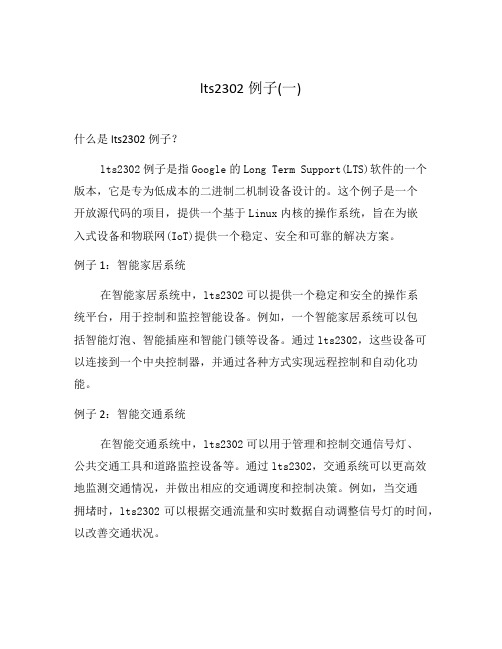
lts2302例子(一)什么是lts2302例子?lts2302例子是指Google的Long Term Support(LTS)软件的一个版本,它是专为低成本的二进制二机制设备设计的。
这个例子是一个开放源代码的项目,提供一个基于Linux内核的操作系统,旨在为嵌入式设备和物联网(IoT)提供一个稳定、安全和可靠的解决方案。
例子1:智能家居系统在智能家居系统中,lts2302可以提供一个稳定和安全的操作系统平台,用于控制和监控智能设备。
例如,一个智能家居系统可以包括智能灯泡、智能插座和智能门锁等设备。
通过lts2302,这些设备可以连接到一个中央控制器,并通过各种方式实现远程控制和自动化功能。
例子2:智能交通系统在智能交通系统中,lts2302可以用于管理和控制交通信号灯、公共交通工具和道路监控设备等。
通过lts2302,交通系统可以更高效地监测交通情况,并做出相应的交通调度和控制决策。
例如,当交通拥堵时,lts2302可以根据交通流量和实时数据自动调整信号灯的时间,以改善交通状况。
例子3:工业自动化系统在工业自动化系统中,lts2302可以用于监控和控制各种工业设备和机器。
例如,一个工厂的生产线可以使用lts2302来优化生产过程和提高生产效率。
通过lts2302,工业自动化系统可以实现设备之间的实时通信和协调,从而实现智能化和自动化的生产过程。
例子4:无人机应用在无人机应用中,lts2302可以提供一个可靠的操作系统平台,用于控制和管理无人机的飞行和任务。
通过lts2302,无人机可以实现自主飞行、航迹规划和图像识别等功能。
同时,lts2302还可以提供网络连接,使无人机能够实现远程控制和数据传输。
例子5:医疗设备在医疗设备领域,lts2302可以用于管理和控制各种医疗设备,如心率监测器、血压计和呼吸机等。
通过lts2302,医疗设备可以实现互联互通和远程监护,提高医疗服务的质量和效率。
同时,lts2302还可以提供数据安全和隐私保护,确保医疗信息的安全性。
谷歌otp原理
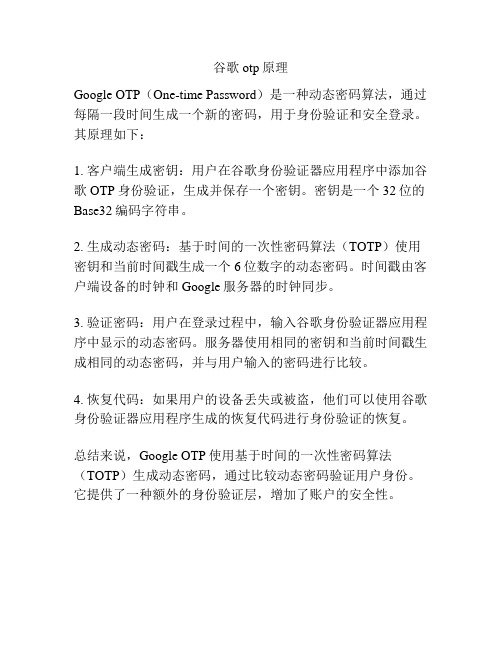
谷歌otp原理
Google OTP(One-time Password)是一种动态密码算法,通过每隔一段时间生成一个新的密码,用于身份验证和安全登录。
其原理如下:
1. 客户端生成密钥:用户在谷歌身份验证器应用程序中添加谷歌OTP身份验证,生成并保存一个密钥。
密钥是一个32位的Base32编码字符串。
2. 生成动态密码:基于时间的一次性密码算法(TOTP)使用密钥和当前时间戳生成一个6位数字的动态密码。
时间戳由客户端设备的时钟和Google服务器的时钟同步。
3. 验证密码:用户在登录过程中,输入谷歌身份验证器应用程序中显示的动态密码。
服务器使用相同的密钥和当前时间戳生成相同的动态密码,并与用户输入的密码进行比较。
4. 恢复代码:如果用户的设备丢失或被盗,他们可以使用谷歌身份验证器应用程序生成的恢复代码进行身份验证的恢复。
总结来说,Google OTP使用基于时间的一次性密码算法(TOTP)生成动态密码,通过比较动态密码验证用户身份。
它提供了一种额外的身份验证层,增加了账户的安全性。
- 1、下载文档前请自行甄别文档内容的完整性,平台不提供额外的编辑、内容补充、找答案等附加服务。
- 2、"仅部分预览"的文档,不可在线预览部分如存在完整性等问题,可反馈申请退款(可完整预览的文档不适用该条件!)。
- 3、如文档侵犯您的权益,请联系客服反馈,我们会尽快为您处理(人工客服工作时间:9:00-18:30)。
IntroductionWe are building an Open Source handsetsolution with built-in Google applicationsWe have created an alliance of interested partners who wish to help define theplatformHandset Commoditization0%10%20%25%$0$50$100$150$200Cost of OSBOM Source: ARCchart estimates20032004200520062007208Software as %of handset costBOM = Bill of Materials, hardware cost of phoneThe Problem•Hardware innovation has out paced softwareinnovation•Wireless Operators have become moredemanding of software capabilities, need abilityto differentiate•Handset OEMs are not modern softwaredevelopment shops and have proved weak atbeing integratorsThe Gapenterprise low-end multimedia proprietaryopenEmbedded MS Smartphone Symbian No Powerful Open OSImproving the core platform•Proven Open Source platform has worldwideadoption•Linux kernel enables hardware abstraction•World class XML based graphics subsystemenables high performance carrier customization•Telephony API’s support multiple semiconductorarchitectures•Application stack supports Smartphone-like featureset•Simulation environment supports off-devicedevelopment•UI mark-up tool enables point and click UI creationImproving the core platform (cont’d)•Google & Alliance will make the integratedJava/Linux Mobile Platform available through anopen source distribution•Companies will be able to adopt this solutionand customize for their own devices &network... Including components, applicationsand branding•The Java platform will be CDC based with theability to run all the midlet-base content•Application framework and optimized graphicssystem built on top of Linux kernelA complete stack is the way to accelerate adoptionFact: Industry noise around Linux is at its all-time high. Still, no one is offering acomplete platform in an open way --instead, we find people using open source as a marketing advantage, and offer only certain layers of the stack.Examples:•Access/PalmSource: Using Linux to build a closed system•Motorola/Samsung/NTT/Vodafone-Japan: Trying to specify apps environment.Where are the software companies?•TrollTech: Green Phone. NOT OPEN.•MLI, LiPS: Specification only, no implementation.Strategy: Open Source the entire stack only after the first devices show up in themarket. Send a strong signal to the industry that they now have everything they need to build devices as-good-as or better than the ones we just released.Supporting Java is the best way to harness developersFact: Linux fragmentation threatens value. Tools and new app frameworks are biggest hurdles. 6M Java developers worldwide. Tools and documentation exist to support app development without the need to create a large developer services organization. There exist many legacy Java applications. The wireless industry has adopted Java, and the carriers require its support.Strategy: Leverage Java for its existing base of developers. Build a useful appframework (not J2ME). Support J2ME apps in compatibility mode. Provide anoptimized JVM (Dalvik). Integrate class libraries and other technology from Skelmir acquisition to accelerate effort.Details•Google & Alliance will make the integrated Java/Linux Mobile Platform available through an open source distribution •Companies will be able to adopt this solution and customize for their own devices & network.... Including components, applications andbranding•The Java platform will be CDC based with the ability to run all the midlet-base content•Application framework and optimized graphics system built on top of Linux kernelHow China Mobile can participate and what benefits it can reapGoogle invites China Mobile to be one of the first carriers to embrace an open OS and make a significant impact on the mobile industry, no just in China, but worldwideAs a participant, China Mobile will be able to–Help shape the OS platform requirements with carrier services in mind–Deploy its next generation mobile devices & services based on this platform–Develop together with Google an innovative handset using the OS to demonstrate power of the open platformBenefits of working with Google–Google has the best mobile software industry experts–Google’s OS is the most open platform with the most flexible license–Google has tremendous expertise in user-centric software design–Google will invest to help China Mobile succeedAppendix –Google handset OS architectureGoogle confidential12。
